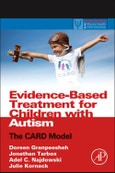This manual is a user-friendly, comprehensive description of the Center for Autism and Related Disorders (CARD) model of autism treatment-the latest scientific information on what truly works in treating autism in an integrated, organized, consumable format. The book details effective early behavioral intervention, covering topics such as challenging behavior, visual modification, parental involvement, improving language, cognition, and social skills, and ends with a section that explains how all of the treatments can be put together in real-life service provision organizations. The CARD model is highly comprehensive and provides useful clinical information to form cutting-edge treatment programs.
- Describes in detail the world-renowned, state-of-the-art CARD model of treatment for children with autism spectrum disorders
- Provides practitioners critical guidance in how to combine the best components into comprehensive treatment programs for individuals with autism that are not only backed by research, but also the most effective, and the least intrusive
- Includes practical information, presented in a user-friendly, professionally-oriented format, with tables, figures, and flowcharts to help guide real-life clinical decision making
Table of Contents
1. Overview 2. CARD Philosophy and Mores 3. Combination and Hierarchy of Treatment Components 4. A Functional Approach to Challenging Behavior 5. Generalization and Maintenance 6. Visual Modifications 7. Training and Quality Control 8. Working Effectively with Other Disciplines 9. Parent Involvement 10. Standardized Psychoeducational Assessment 11. Technology 12. Introduction: CARD Curriculum 13. Language 14. Social Skills 15. Cognition 16. Executive Functions 17. Academics 18. Adaptive 19. Motor 20. Play 21. Settings 22. Job Descriptions 23. Case Management 24. Global Dissemination 25. Research








